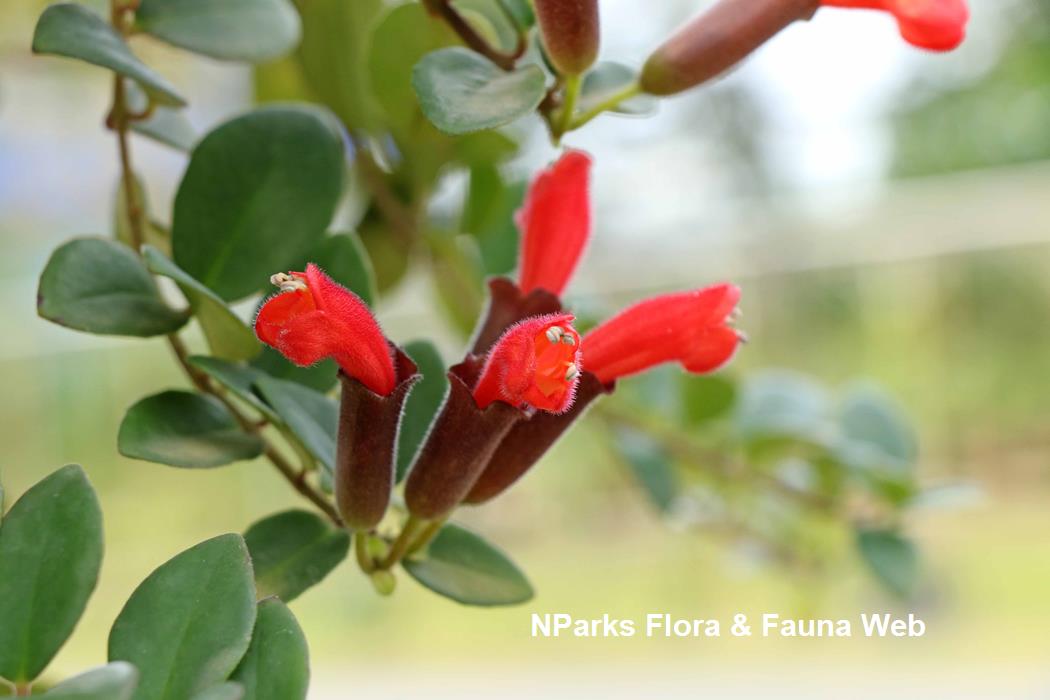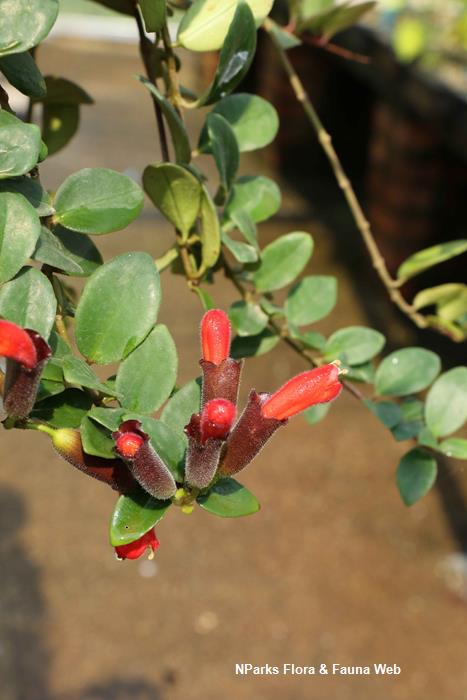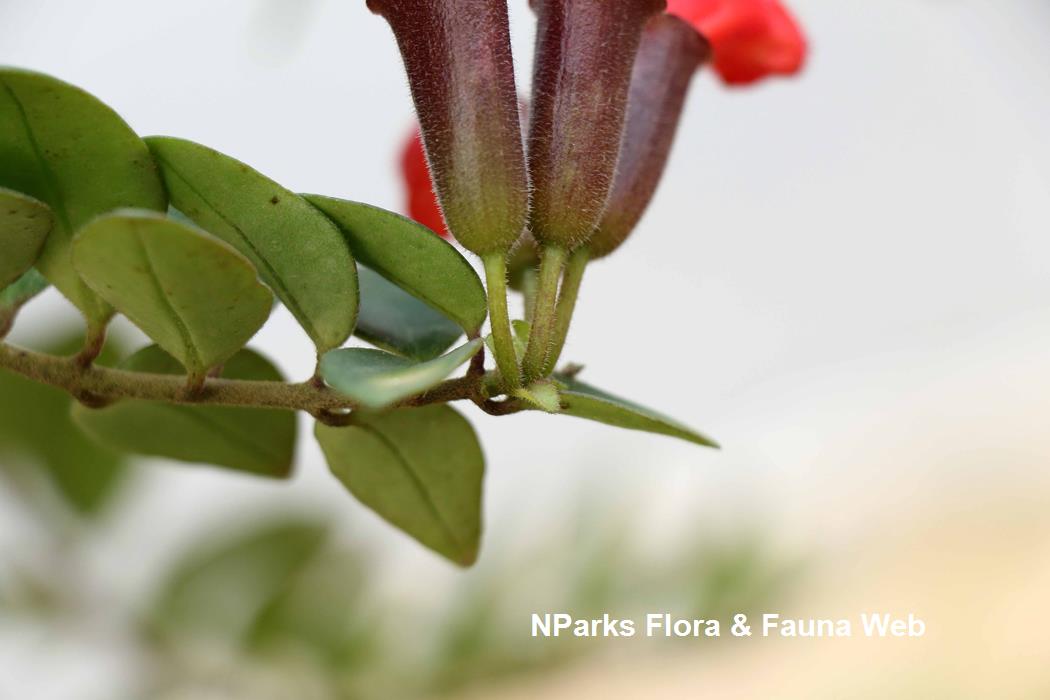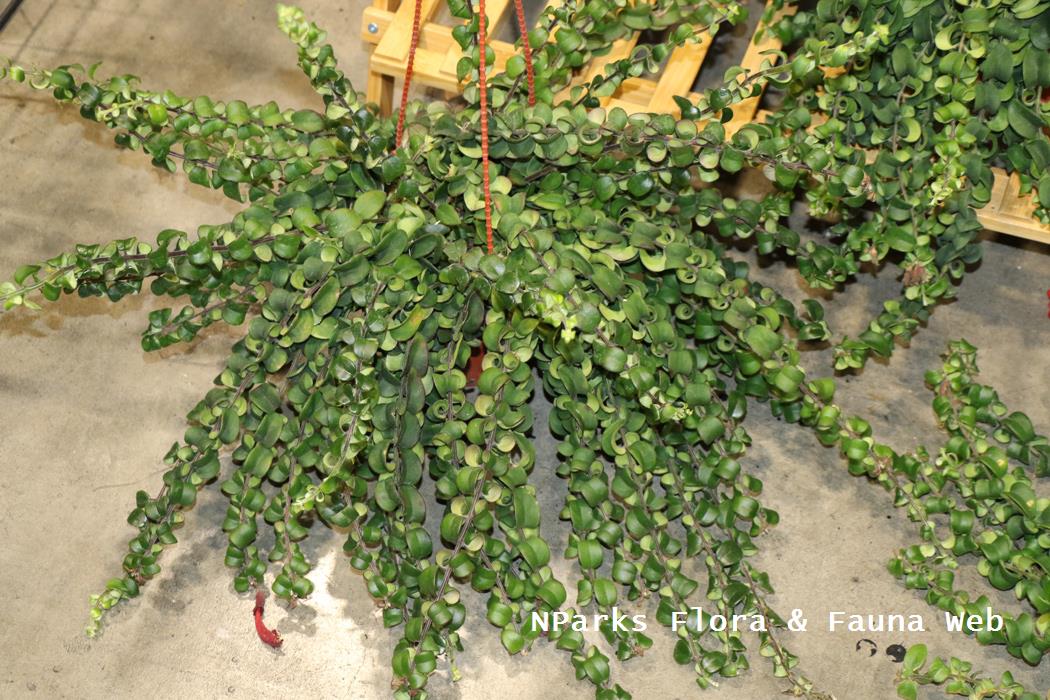
Back
Aeschynanthus pulcher (Blume) G.Don
| Family Name: | Gesneriaceae |
| Synonyms: | Aeschynanthus lobbianus, Aeschynanthus parvifolius |
| Common Name: | Lipstick Plant, 口红花 |
Aeschynanthus pulcher is our native epiphyte that boasts clusters of bright red buds emerging from the dark maroon tubular calyx, hence the common name Lipstick Plant. This plant enjoys being under semi-shade on well-drained soils in hanging baskets, a great addition as indoor plant!
Name
Classifications and Characteristics
| Plant Division | Angiosperms (Flowering Seed Plants) (Dicotyledon) |
|---|---|
| Plant Growth Form | Epiphyte, Climber |
| Lifespan (in Singapore) | Perennial |
| Mode of Nutrition | Autotrophic |
| Maximum Height | 0.5 m to 1 m |
| Maximum Plant Spread / Crown Width | 0.1 m to 0.5 m |
Biogeography
| Native Distribution | Thailand, Singapore, Peninsular Malaysia, Sumatra, Java, Sarawak & Kalimantan |
|---|---|
| Native Habitat | Terrestrial (Primary Rainforest) |
| Preferred Climate Zone | Tropical |
| Local Conservation Status | Native to Singapore (Critically Endangered (CR)) |
Description and Ethnobotany
| Growth Form | A herbaceous trailing shrub or epiphyte, can also be a lithophyte. |
|---|---|
| Foliage | Thick, fleshy leaves are elliptic or ovate with smooth leaf edges. They are oppositely arranged in pairs along long trailing stems. Leaves are smooth on the upper surface, with rarely sparsely pubescent on the undersides. Petiole 1-3 (sometimes up to 6) mm long. Leaf blades are dark green to purple, apex rounded to acuminate, base subcordate to cuneate. |
| Stems | Dark purple to green, sparsely hairy to smooth. |
| Flowers | Bright red, tubular flowers are surrounded at the base by a dark red to maroon tubular calyx (collective group of sepals that forms the outermost layer of the flower). The outer surface of the calyx and corolla (collective group of petals which are fused together to form a tube in this species) are densely covered in short, white hairs. The flowers are vertically oriented and arranged in small clusters at the stem tips. |
| Fruit | Fruit are capsule, 18–40 cm long and 2–4 mm wide. |
| Habitat | Found on rocks or tree branches. It is most common in lower montane forest, and sometimes in lowland, hill dipterocarp or upper montane forest, in peat swamp forest or in forest on quartzite or sandstone, at 0–2100 m altitude. |
| Similar | It has close resemblance to Aeschynanthus radicans. Aeschynanthus radicans can be distinguished by the hairs on the ovary, Aeschynanthus pulcher's ovary is smooth. |
| Cultivation | Grow in soil mix with good drainage and aeration, and plant best grown under semi-shade or bright filtered light condition. Allow top portion of media (about 1 quarter of the pot) to dry before watering. Stems can be pruned to promote bushiness and create more blooms. The cuttings can be used for propagation. Place the cut end of the stem into the moist soil, and place pot in a warm location where it receives bright, indirect sunlight. |
| Etymology | The genus Aeschynanthus is from the Greek words aischune meaning shame and anthos meaning flower referring to the red flowers. The species epithet pulcher means beautiful. |
Landscaping Features
| Landscaping | Commonly cultivated in hanging baskets for it's attractive lipstick-like clusters of flowers. |
|---|---|
| Desirable Plant Features | Ornamental Foliage, Ornamental Flowers |
| Landscape Uses | Suitable for Hanging Baskets, Interiorscape/ Indoor Plant |
Fauna, Pollination and Dispersal
| Fauna Pollination Dispersal Associated Fauna | Bird-Attracting (Flowers) |
|---|---|
| Pollination Method(s) | Biotic (Fauna) (Vertebrates (Bird)) |
Plant Care and Propagation
| Light Preference | Semi-Shade |
|---|---|
| Water Preference | Moderate Water, Occasional Misting |
| Plant Growth Rate | Moderate |
| Rootzone Tolerance | Well-Drained Soils |
| Propagation Method | Stem Cutting |
Foliar
| Foliage Retention | Evergreen |
|---|---|
| Mature Foliage Colour(s) | Green |
| Mature Foliage Texture(s) | Thick |
| Prominent Young Flush Colour(s) | Green |
| Young Flush Texture(s) | Thick |
| Foliar Type | Simple / Unifoliate |
| Foliar Arrangement Along Stem | Opposite |
| Foliar Attachment to Stem | Petiolate |
| Foliar Shape(s) | Non-Palm Foliage (Elliptical, Ovate) |
| Foliar Venation | Pinnate / Net |
| Foliar Margin | Entire |
| Foliar Apex - Tip | Acute, Acuminate, Rounded |
| Foliar Base | Cuneate, Acute |
Non - Foliar and Storage
| Stem Type & Modification | Woody |
|---|---|
| Root Type | Underground |
Floral (Angiosperm)
| Flower & Plant Sexuality | Bisexual Flowers |
| Flower Colour(s) | Red |
|---|---|
| Flower Texture(s) | Smooth |
| Flower Grouping | Cluster / Inflorescence |
| Flower Location | Terminal |
| Flower Symmetry | Bilateral |
| Individual Flower Shape | Tubular |
| Inflorescence Type | Umbel |
| Flowering Habit | Polycarpic |
Fruit, Seed and Spore
| Fruit Classification | Simple Fruit |
|---|---|
| Fruit Type | Dehiscent Dry Fruit , Capsule |
| Seed Description | Grain, measuring 0.6–0.9 × 0.2–0.3 mm, papillose. |
References
| References | Wiguna Rahman (2011) Flower biology of four epiphytic Malesian Gesneriads. Gardens’ Bulletin Singapore 63(1 & 2): 485–493. 2011 D.J. Middleton (2016) A revision of Aeschynanthus (Gesneriaceae) in Singapore and Peninsular Malaysia. Gardens’ Bulletin Singapore 68(1): 1–63. 2016 |
|---|
Image Repository
Others
| Master ID | 2 |
|---|---|
| Species ID | 1298 |
| Flora Disclaimer | The information in this website has been compiled from reliable sources, such as reference works on medicinal plants. It is not a substitute for medical advice or treatment and NParks does not purport to provide any medical advice. Readers should always consult his/her physician before using or consuming a plant for medicinal purposes. |


















.jpg)